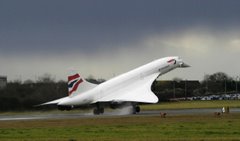Madrid is a magnificent city, with splendid avenues, superb buildings, incredible museums and terrific tapas bars. The only missing is water: actually, the Manzanares, the river that crosses Madrid, is far from being remarkable… Some say the weather is awful (nine months invierno (winter), three months infierno (Hell)), but the fantastic cultural life, as well as the glorious night life used to compensate everything. It started in the late 70s of last century, when Enrique Tierno Galvan became mayor ("la Movida"), and there have been several movidas after him. I don’t know how are things today (we are so close that we don’t go there that often, but I’ve to re-visit it one of these days), but meanwhile you can enjoy the different aspects of Madrid at the wonderful Dsole’s blog. It has beautiful pictures, much better than the somehow lousy photos you can find herein below...

"COLON - On the Paseo de la Castellana side of the Plaza de Colón, originally called St. James Square, there is a monument built in 1885 with a statue honouring Christopher Columbus, at the top of a tall column"

"CIBELES - The Plaza de Cibeles is a beautiful square with a wonderful fountain in the Paseo de Recoletos. It shows Cybele, the Phrygian goddess of fertility, sitting on a chariot and being pulled by two lions. On one of the corners of the Plaza there is the «wedding cake», a stunning building housing the headquarters of Correos y Telegrafos, the Spanish Post"

"REINA SOFIA - On the right hand side of the photo, we can see part of the façade of the Museo Nacional Centro de Arte Reina Sofía, Madrid's 20th century art museum: the third location where I saw Picasso's Guernica. At the distance, there is the Atocha railway station where bombing attacks took place on March 11, 2004"


"ATOCHA - The old building of the railway station was taken out of service in 1992 and converted into a concourse with shops, cafés, a nightclub, and a 4,000 square meter covered tropical garden"

"PARQUE DEL BUEN RETIRO is a 1.4 square kilometre park in the city centre, not far from the Prado Museum. Originally the site of a royal palace built in 1632 that was destroyed during the Napoleonic Wars, it opened to the public as a park in 1868"

"ALFONSO XII - Within the Retiro Park there is a large artificial lake, next to which one can find the Mausoleum of Alfonso XII, featuring a semicircular colonnade and a statue of Alfonso on horseback on a tall pedestal"

"BOTERO - A nice sculpture from Fernando Botero, with the now renamed Gran Melia Fenix Hotel in the background"

"DON QUIXOTE - The most popular sight at the Plaza de España is the monument to Miguel de Cervantes Saavedra, writer of «El ingenioso hidalgo Don Quixote de La Mancha». Visitors get their pictures taken in front of the bronze statues of Don Quixote on his horse and Sancho Panza on his mule. Behind them there is a statue of Cervantes himself. At night one can hardly see anything; furthermore with such a lousy camera..."

"VELASQUEZ - In front of the Prado Museum there is a statue of Velasquez, anticipating Las Meninas"

"PLAZA MAYOR - I prefer the Plaza Mayor at Salamanca, but this one is also a beautiful squre!"


"AYUNTAMIENTO - Some VIP was supposed to be inside, as there were almost as much security people as normal pedestrians..."


"CASA DE CAMPO is the largest park in Madrid (1,722 hectares to compare with the 142 hectares of Retiro Park and Central Park's 340 hectares. It used to be the hunting grounds for the Spanish Monarchy until May 1st, 1931, when it was donated to the public, under the Second Republic"

"PLAZA DE ORIENTE - View towards the Royal Palace"

"ROYAL PALACE - The Palacio de Oriente is the official residence of the King of Spain, used for state ceremonies only. Actually the royal family lives at the Palace of Zarzuela, on the outskirts of Madrid"

"ALMUDENA CATHEDRAL"

"PRECIADOS - The Street had the same name as the shopping mall that occupied most of its space. Later, it became Corte Ingles, but La Oficina still had nice tapas. I wonder whether it still exists..."

"INTERCONTINENTAL - Lounge at the Intercontinental Hotel, Paseo de La Castellana"



































